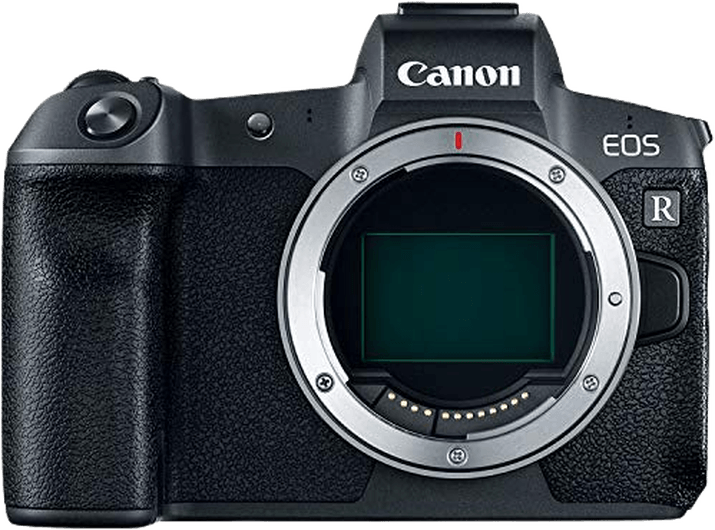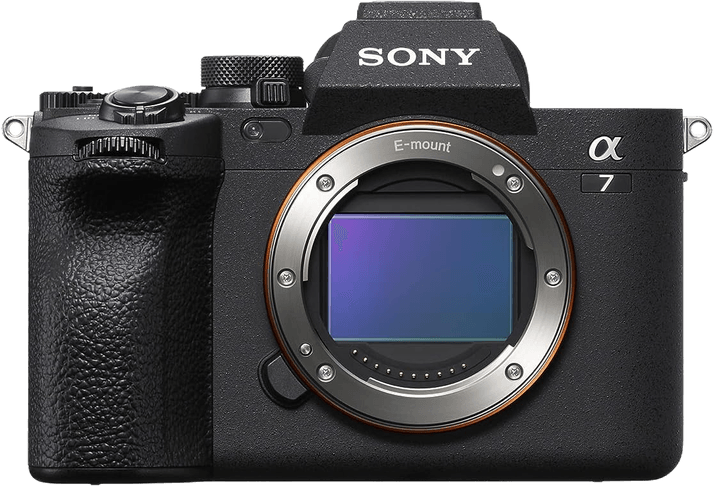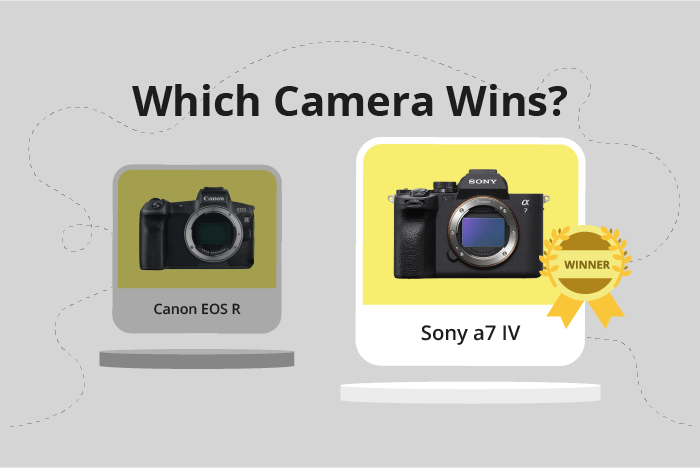Canon EOS R vs Sony a7 IV Comparison
Canon EOS R

Sony a7 IV

The Sony a7 IV outshines the Canon EOS R with a score of 84/100, compared to Canon’s 74/100. Both cameras are mirrorless and share similarities in size and launch prices, with the Canon EOS R being slightly larger at 136 x 98 x 84mm and the Sony a7 IV at 131 x 96 x 80mm. The Canon EOS R is lighter, weighing 485g, while the Sony a7 IV weighs 659g.
The Sony a7 IV’s higher score reflects its superior performance and features. However, the Canon EOS R has its advantages, such as being lighter and having a lower launch price of $2300 compared to the Sony a7 IV’s $2499.
Considering both cameras’ specifications and scores, the Sony a7 IV is the clear winner in terms of performance and quality. The Canon EOS R, on the other hand, offers a more budget-friendly and lightweight option for those prioritizing cost and portability.
Canon EOS R vs Sony a7 IV Overview and Optics
The Sony a7 IV outperforms the Canon EOS R in optics with a score of 85/100 compared to Canon’s 73/100. Both cameras share some common specifications, such as having a CMOS sensor, full-frame sensor size, and similar lens mounts (Canon RF and Sony FE). However, there are key differences that contribute to the Sony a7 IV’s higher score.
The Sony a7 IV has a higher megapixel count at 33, compared to the Canon EOS R’s 30.3, providing more detailed and sharper images. Its shooting speed of 10 frames per second is also faster than the Canon EOS R’s 8 frames per second, allowing for better capture of fast-moving subjects. The Sony a7 IV’s Bionz XR processor offers improved performance and efficiency compared to the Canon EOS R’s Digic 8 processor. Additionally, the Sony a7 IV’s DXOMARK sensor score of 97 surpasses the Canon EOS R’s score of 89, indicating better overall image quality.
The Canon EOS R has certain advantages, although they are not enough to surpass the Sony a7 IV. Its RF lens mount supports a growing range of high-quality lenses. However, the Sony FE mount has a more extensive selection of lenses currently available.
One notable advantage of the Sony a7 IV is its in-body image stabilization, which the Canon EOS R lacks. This feature helps reduce camera shake and allows for sharper images, particularly in low-light situations or when using slower shutter speeds.
Taking all these factors into account, it is clear that the Sony a7 IV offers superior optics compared to the Canon EOS R. Its higher megapixel count, faster shooting speed, better processor, higher DXOMARK sensor score, and image stabilization contribute to its higher overall score. While the Canon EOS R has some merits, it falls short in comparison to the Sony a7 IV’s capabilities.
Canon EOS R vs Sony a7 IV Video Performance
The Sony a7 IV outperforms the Canon EOS R in video capabilities, with a score of 91/100 compared to the Canon’s 70/100. Both cameras offer 4K video resolution with a maximum dimension of 3840 x 2160, and both have built-in time-lapse functionality. However, the Sony a7 IV has several advantages over the Canon EOS R, making it the superior choice for videographers.
One significant advantage of the Sony a7 IV is its higher maximum video frame rate of 120fps, compared to the Canon EOS R’s 30fps. This allows the Sony a7 IV to capture smoother slow-motion footage, which is crucial for many video applications. The higher frame rate also provides more flexibility in post-production, as it enables users to slow down or speed up their footage without losing quality.
The Canon EOS R, on the other hand, has no significant advantages in video capabilities over the Sony a7 IV. Its lower video score and limited frame rate make it a less suitable choice for videographers who prioritize high-quality video performance.
To sum up, the Sony a7 IV is the clear winner in terms of video capabilities. Its higher score reflects its superior performance, particularly its higher maximum video frame rate. While both cameras share some common specifications, such as 4K video resolution and built-in time-lapse functionality, the Sony a7 IV’s additional capabilities make it the better choice for those seeking a camera with strong video performance. Conversely, the Canon EOS R falls short in this area, making it less desirable for videographers who require advanced video features.
Canon EOS R vs Sony a7 IV Features and Benefits
The Canon EOS R takes the lead in features with a score of 87/100, while the Sony a7 IV trails behind with a score of 83/100. Both cameras share some common specifications, such as touchscreen capabilities, flip screens, GPS, WIFI, and Bluetooth connectivity. However, the Canon EOS R outshines the Sony a7 IV in certain aspects, making it the winner in this comparison.
The Canon EOS R boasts a larger screen size of 3.2 inches, compared to the Sony a7 IV’s 3-inch screen. This difference allows for a more enjoyable and comfortable viewing experience when composing and reviewing images. Additionally, the Canon EOS R has a higher screen resolution of 2,100,000 dots, nearly double the Sony a7 IV’s 1,040,000 dots, providing a clearer and more detailed display.
While the Canon EOS R holds an advantage in screen size and resolution, the Sony a7 IV still has its merits. Both cameras have touchscreen capabilities, flip screens, GPS, WIFI, and Bluetooth connectivity, making them equally convenient and versatile for various shooting situations. These shared specifications ensure that both cameras offer a good user experience and cater to the needs of modern photographers.
In comparing the Canon EOS R and Sony a7 IV in terms of features, the Canon EOS R emerges as the better option due to its larger screen size and higher screen resolution. However, the Sony a7 IV remains a strong contender with its shared specifications, making it a suitable choice for those who prioritize other aspects of a camera. Ultimately, the decision between these two cameras will depend on individual preferences and priorities.
Canon EOS R vs Sony a7 IV Storage and Battery
The Sony a7 IV outperforms the Canon EOS R in storage and battery, scoring 76 points compared to Canon’s 35 points. Both cameras accept UHS-II compatible SD cards and offer USB charging. However, the Sony a7 IV has two memory card slots, supporting CFexpress Type A and SD cards, while the Canon EOS R has only one slot for SD cards.
The Sony a7 IV also boasts a longer battery life, providing 580 shots per charge with its NP-FZ100 battery. In contrast, the Canon EOS R delivers 370 shots using the LP-E6N battery. Although the Canon EOS R falls short in storage and battery life, it is still a reliable camera for casual photographers.
Considering the differences, the Sony a7 IV is a better choice for professionals and enthusiasts who require more storage options and longer battery life. The Canon EOS R remains a suitable option for those with less demanding storage and battery needs.
Canon EOS R vs Sony a7 IV – Our Verdict
Are you still undecided about which camera is right for you? Have a look at these popular comparisons that feature the Canon EOS R or the Sony a7 IV:

